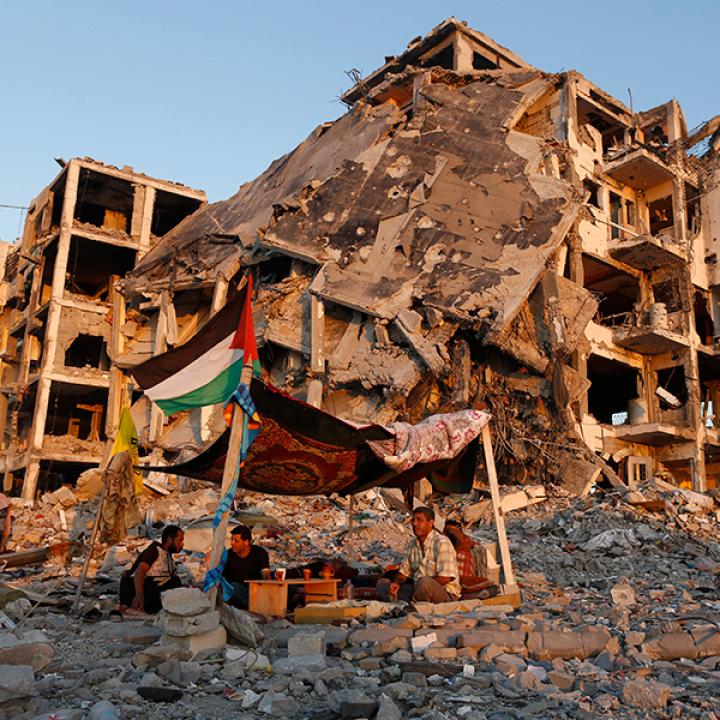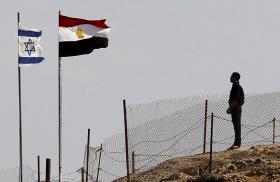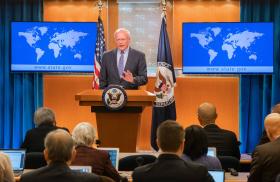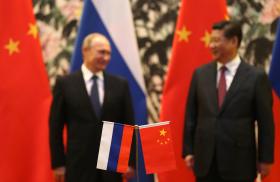
- Policy Analysis
- PolicyWatch 4089
How “Day After” Governance of Gaza Can Draw from Existing Plans

NGOs and foreign officials have already outlined many of the most crucial transitional governance and security issues that will arise during and after Israel’s eventual withdrawal—and all of them will require some degree of oversight and leadership from the Trump administration.
In announcing their August 8 decision to temporarily “take over” all of Gaza, Israeli officials issued a set of principles for how Arab states could oversee governance of the Strip after Israel’s presence ends. Although these principles provided few details and no timeline, they clarified several important points, such as Israel’s desire to exercise some sort of security oversight, bar Hamas or the Palestinian Authority from governing Gaza, and demilitarize the territory.
These conditions are not new, of course—Israelis have worked with Arab and American interlocutors on various “day after” models for over eighteen months, and some of these models have been discussed with Palestinian officials. Yet this is the first time that the Israeli government has taken a formal position on governance and linked it to a commitment to withdraw all of its forces.
The most crucial issues that any Gaza governance plan would need to address have already been discussed to varying degrees by three of the previous “day after” models:
- A proposed plan worked out by American and Israeli experts, published by the Wilson Center in early 2024, and shared with Israeli officials. (Disclosure: The author was involved in formulating the Wilson plan during his tenure as chair of the center’s Middle East Program.)
- A RAND Corporation plan released this year and widely briefed within the U.S. government.
- A set of principles issued by the United Arab Emirates and deemed a likelier candidate than other Arab plans given Abu Dhabi’s more realistic proposals and its closer relations with Israel.
Above all, experts involved in past discussions have generally agreed that a leading U.S. diplomatic and oversight role will be absolutely essential to any transitional governance plan, particularly if the Trump administration intends to avoid committing substantial American military and financial resources to Gaza.
Composition, Authorization, and Missions
The Wilson plan—the most comprehensive of the three regarding composition issues—proposes an Arab-led “Multi-National Authority” (MNA) that would include European elements and possibly UN entities. This authority would be overseen by an international contact group with many of the same members, though with the addition of the G7 members and a leading role for the United States (informal if necessary). In addition, the plan calls for the MNA to oversee an international “policing force.”
The MNA’s main missions would be to temporarily administer Gaza, establish security, remove Hamas control of civil governance, initiate physical and social reconstruction, and provide better conditions for the people of Gaza. The plan would culminate in a transition to local Palestinian governance and security along lines established by a “charter” of some type (see below). Yet drafting and agreeing on this charter must not hold up the urgent process of standing up the MNA.
The RAND study takes a similar approach, proposing an “interim multinational security force” drawn from Western and Arab militaries, with support from a vetted and trained Palestinian security force. The UAE proposal calls for a “temporary international mission,” offering few details on its composition but clearly outlining a transition to Gazan self-governance at minimum—the end state envisioned by all three plans.
Responsibility. Each plan notes that the governing entity must be in charge of every aspect of Gaza’s transition and reconstruction, and that it must remain open to U.S. guidance. This is a tall order given the role to be played by the UN and various aid NGOs. Yet there are successful precedents, including the Bosnian arrangements outlined in the Dayton Accords and formalized in Security Council Resolution 1031.
Carrots-sticks linkage. Senior Israeli and U.S. officials expressed appreciation when previous plans firmly and formally conditioned the provision of Gaza assistance on Palestinian adherence to the security provisions of the “charter” establishing the governance structure. This is critical to avoid the problems seen with Lebanon’s postwar settlement after 2006, when major UN, European, and U.S. reconstruction efforts were not conditioned on disarming Hezbollah or meeting other key provisions of Security Council Resolution 1701. In contrast, the Dayton Accords and paragraph 10 of Resolution 1031 established strict linkage.
Legal authority. The temporary international takeover of governance in Gaza could be based on any of several legal alternatives, though the first two would likely be diplomatically problematic: (1) the PA ceding temporary responsibility; (2) the UN Security Council drafting a sturdy resolution under Chapter VII that gives the governing authority a one-time, non-renewable mandate with no direct UN management role (analogous to Resolution 1546, which authorized the U.S.-led multinational force to govern Iraq in 2004); (3) Israel taking responsibility for Gaza as an occupying power under international law and then transferring its authority to the MNA pursuant to a memorandum of understanding; or (4) the international authority establishing its own charter as a coalition of the willing.
American roles. The Wilson and RAND plans call for a major U.S. role in choreographing the establishment of both the MNA and the contact group. One option is to fold the U.S. government-supported Gaza Humanitarian Foundation into the MNA (see the next section for more on the security aspects of the U.S. role). Washington would also have to facilitate efforts to meet civilian needs beyond direct aid provision, such as helping to reestablish the local Palestinian institutions now in disarray. (The RAND plan outlines these steps.)
Specific Issues
Hamas and the transition. All plans assume some prior resolution of the Hamas-Israel conflict based on a ceasefire. As noted above, this ceasefire deal would include a “charter” covering the deployment and operational ground rules of an international presence, agreed to by whatever is left of Hamas. None of the plans detail the contents or modalities of such a deal, but all assume that foreign forces would not seek to combat Hamas, but rather to conduct normal policing activities and defend themselves if necessary.
Relatedly, while the prospect of Israel fully eliminating Hamas’s insurgent military capabilities seems impossible, certain Israeli actions could have positive effects. For instance, continuing some degree of military pressure, separating insurgents from the bulk of the population, and blocking weapons flows could all push Hamas into a weaker position, perhaps making the group more amenable to a deal in which it agrees to tolerate transitional international governance in return for Israel withdrawing.
As for the terms of a Hamas deal—whether with Israel or the international authority—a ceasefire along the lines of the recent negotiations led by Egypt and Qatar is the most likely scenario. During the transition, the group’s status in Gaza could resemble the posture of the Republika Srpska (Bosnian Serb) forces after the Dayton Accords, the type of leadership departure seen when Yasser Arafat left Lebanon in 1982, or the current Hamas situation in the West Bank. What it must not resemble is the 2006 Lebanon ceasefire, after which Hezbollah ignored international provisions and threatened peacekeepers. Whatever the arrangement, all parties should be clear on one principle—that eliminating Hamas’s ability to militarily threaten Israel or contest governance in Gaza is a prerequisite for Israel to withdraw and for an international presence to go in.
Palestinian Authority role. Although Israeli interlocutors advised the drafters of the Wilson plan to avoid specific references to a PA governance role, some of these interlocutors acknowledged that the PA would probably have to play some administrative role given its legal status and its many remaining employees in Gaza. The PA would also have to green-light—and probably participate in—any formal Arab role in Gaza. The UAE plan emphasizes a leading role for the PA, though unlike other Arab plans, it also notes that PA reform is a prerequisite for this role. The Wilson and RAND plans both envision an eventual transition to Gazan governance and primary security, without spelling out relationships to the PA.
Relationship to the Israeli-Palestinian conflict. The Wilson plan does not link Gaza stabilization with progress toward wider Israeli-Palestinian peacemaking, and the Israeli government has made clear that these two issues are separate. Yet the RAND and UAE approaches directly link them. Presumably, these incompatible positions can be negotiated to a compromise, but that would almost certainly require a U.S. role.
Israeli security. Israel correctly insists that it will need to play a security oversight role in Gaza post-withdrawal, presumably including the right to take military action against immediate threats. Given the territory’s small size, coordinating such action with the international force would be essential.
UN role. Whether UN bodies formally authorize the international presence or not, the Security Council and General Assembly will no doubt insist on various oversight roles, which the United States will need to manage carefully given Israel’s legitimate sensitivity about UN politicization. On the technical level, UN agencies can provide unparalleled expertise, and Arab participants will likely demand their involvement. Israel has ample cause to demand that one of these organizations—the UN Relief and Works Agency—leave Gaza. If so, the UN High Commissioner for Refugees will need to work with various NGOs and foreign government agencies to backfill UNRWA’s missions, as seen already with the World Food Programme, Anera, and other organizations.
Depoliticization. Israeli interlocutors have emphasized the need for any transitional authority to keep anti-Israel hate messaging out of Gaza schools, cultural organizations, and official media. This is obviously a delicate undertaking, but nevertheless obligatory if Gazans are to live side by side with Israel in the long term. Of course, the first step in this process would be to reestablish destroyed schools and other civil society institutions.
U.S. military role. None of the plans envisions a significant, direct role for U.S. troops in Gaza security, but Washington does have some essential roles to play in this regard and should begin preparing accordingly. First, it could expand the private security forces it has already supported as part of the Gaza Humanitarian Foundation, integrating them into the international security force. Second, the Office of the U.S. Security Coordinator (USSC) is still working with Palestinian security forces in the West Bank and could assist efforts to stand up Gazan security elements. Third, the U.S. military could operate a liaison headquarters in Egypt, Israel, or offshore to support international forces, providing command-and-control capabilities, staff, logistics, intelligence, and, in extremis, direct assistance (e.g., medevac; quick reaction forces; counterterrorism operations).
Early recovery, reconstruction, and economic development. The Wilson and RAND plans cover this crucial element in detail. The cost will be staggering (estimated at more than $50 billion by the World Bank), but the international community has the means, experience, and motivation to succeed if all of the above organizational, security, and political arrangements are effectively implemented. This element will also require careful negotiation and planning of education and healthcare needs, as well as the complex considerations involved in reconstruction (as laid out in the RAND plan).
James Jeffrey recently rejoined The Washington Institute as the Philip Solondz Distinguished Fellow. His distinguished government career has included service as U.S. special envoy to Syria and ambassador to Turkey and Iraq.



